Lets return to two of the pictures from my first post on German dresses, because they are such lovely artwork, and I've managed to find a few more pages.
I said last time before I knew that they were from the same workshop
- Helmarshauen is now a suburb of Bad Karlsruhe in central Germany (Hessen)
- Apparently the vertically elongated figures are to be expected due to the influence of the english Matilde, who became empress
This is all still true. Helmarhausen abbey was important centre of illumination, Duke Henry commissioned both these manuscripts and several others. The Gospel is considered the best work of this monastery.
Gospel of Henry the Lion
Helmarshausen. Gospels of Henry the Lion from Brunswich, MS Guelph 105 Noviss 2°, c1188 (Herzog August Bibliothek, Wolfenbüttel)
Whole page views online (don't forget to check next 3 pages).

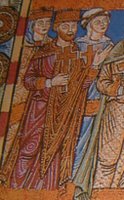

1st 3 images:
- A repeat of the one we saw earlier, but this time so we can see the style of another family member, in a green dress. Note trim at waist.
- Henry's relatives, one in blue has trim at waist and has the interesting headwrap that we've seen before. The other wears a mantle concealing everything (but what a pretty mantle).
- Matilde wears the longest sleeves of anyone, but we can't see many other details other than patterned fabric, because of her pretty fur lined mantle.

next image: fol 19 dedication image
- This is Matilde, Henry's english wife herself, richly dressed.
- her underlayer is a rich cream colour, although maybe the artist just wanted to differentiate it from the fur lining of her mantle.
- her sleeves are longer than anyone else's and have a white lining.



Next 3 images: fol 170v Crucifixtion
- Can't be sure middle figure is female, but long plaits suggest this.
- Being a crucifixtion scene the first figure, the only female saint present, has to be the mother Mary. The third figure might be a virtue (something about her posture) and the second could be likewise or could be the donor (Matilde), or I could have it all wrong.
- examples of full length dresses alongside patterned ones - probably do represent co-existant fashions, with the younger figure (hair out instead of veil) wearing the fancier fashion.
- Lots of gorgeously coloured veils
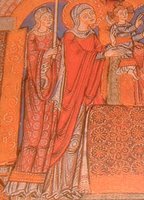

2 images: fol 111 presentation in the temple
- Mary (holding Jesus) wears a full length dress veil and wrap
- to the left of Mary, an attendant (might be a virtue) wears the fancier fashion with her hair uncovered
- the attendant's fabric is shown with rondell patterns - a popular design in fabrics of the time (especially expensive imported silks).
- A pilgrim saint (holding pilgrim's walking stick) watches, also dressed conservatively rather than fashionably

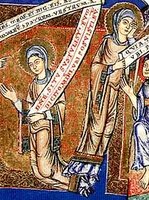
2 images: fol. 171r Mary meets the desciples, Jesus sends Mary to the desciples and Mary at the grave.
- This page is most comic book like - it's the adventures of Mary during the resurection, in reverse order.
- With the comic book theme, Mary is dressed almost identically in all pictures (her trim might change a little, but that's all). We can see the same costume in different postures.
- Her dress is belted up a little (see the sag line at her waist) presumably by a thin cord, since no belt shows
- This time she is not being presented very conservatively, but a little more loosely - she wears the fashions, but is veiled as a married woman is likely to be.
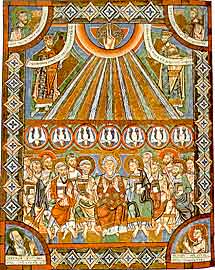
image details unknown
You can't see this page very well, because the original image is so small (if anyone has a better copy....), but you can see in the bottom centre a female saint, almost certainly the 'virgin' mary, and see that her tunic hem is higher than the white layer underneath.
Psalter of Henry the Lion
Psalter of Henry the Lion, MS Lansdowne 381 fol 8, Helmarshausen 1168/89 (British Library)
Can be found online courtesty of the British Library.

1st figure: fol. 7v Annunciation
- Will be Mary, since she's the only female present and this is the annunciation
- While she has a conservative wrap and veil, she has a shorter patterned dress
- She has fancy wrinkled chemise sleeves

2nd figure: fol 10v Mary at the Crucifixtion
- Again, a conservative wrap and veil, but a shorter dress, this time unpatterned. Perhaps this artist is tying to copy/match with the artist above (who seems better at clothing and detail, but worse at people and proportion)
 3rd figure: fol8v The presentation at the temple
3rd figure: fol8v The presentation at the temple- I've already shown you a black and white copy of this - but this is colour.
- An attendant to Mary, possibly a virtue, and dressed almost identically to the one in the gospel, except the colour at pattern of her tunic
- her tunic is in a cross style - another popular design we see in extant textiles
- The vertical trim could be a belt or it could be imitating byzantine styles, or it might be trim, but it looks a little awkward where it meets the base trim.
- Notice she might have a slight wrinkly sleeve syndrome happening. Interesting.
Comparison (because I can't help myself)
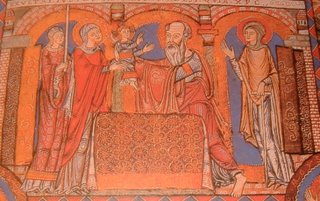

First image is from the gospel, the second the psalter. You can successfully play spot 11 differences here, but the artist has definately copied a successful scene from one to the other. His changes have probably been primarily concerned with colour and spacial balance, and accomodating appropriate thematic elements (the pilgrim saint only present in one). This is a nice example of how artists worked from models such as other manuscripts, but it also shows how much variability could be instilled into the same scene too. (I'll come back to this topic later when I get around to rambling about byzantine origins). The psalter (second picture) is probably the earlier one of the two.

1 comment:
Here, too, I think the figure in green and the one with the scroll from fol. 170v are, respectively, Ecclesia and Synagoga; so yes, the one in green is female; but both are allegorical.
What are those wrinkles on Synagoga's dress? They're higher than I've seen on similar garments, as if the dress is laced only right under the arms...? Does that make any sense?
I might have guessed that her dress is deliberately made as plain as possible were it not for the generous sleeves. What do you think?
Thanks,
Raina
Post a Comment